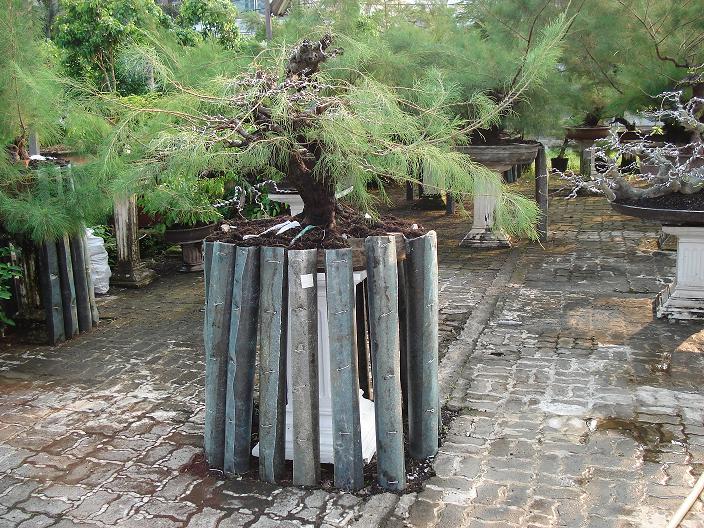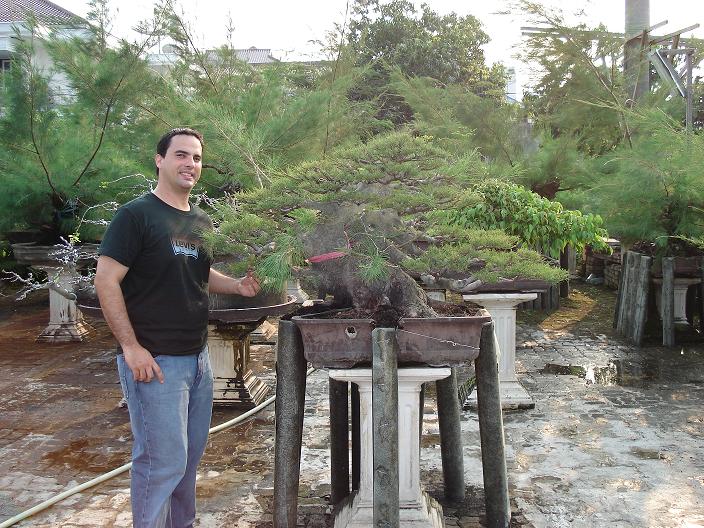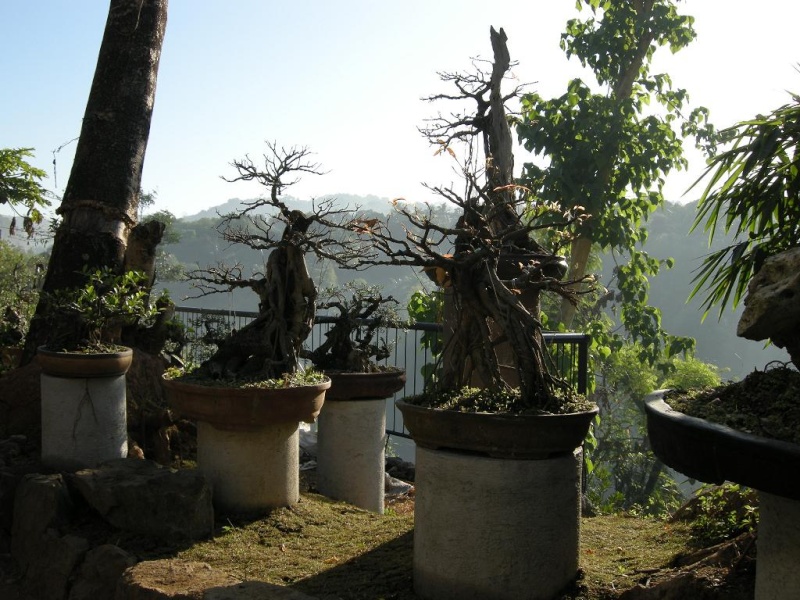Casuarina Equisetifolia (Cemara Udang or Mu Ma Huang)
+26
Khaimraj Seepersad
my nellie
ponsmaldo
Robert Steven
ogi uyehara
jonathan e
siriwatn
kcpoole
Peter Woosley
craigw
BonsaiAndino
allan
leonardo
Ka Pabling
gm.it.seacom
Ed Trout
Chris Cochrane
Rob Kempinski
ArtAtkinson
cosmos
priya uthama
hiram
Billy M. Rhodes
sentot
Garykk
jrodriguez
30 posters
Page 2 of 5
Page 2 of 5 •  1, 2, 3, 4, 5
1, 2, 3, 4, 5 
 Creating a great nebari
Creating a great nebari
Hi Jose,
In the begining of this thread I mentioned that I have found a picture of how one can create great nebari on Casuarina. You replied and said that the technique I mentioned was developed in Pluit, a suburb in Jakarta, Indonesia. You also promised to post several pictorials on this technique. I would be very happy if you post some of these pictures so that I could understand it better. Thanks.
Regards
Cosmos
In the begining of this thread I mentioned that I have found a picture of how one can create great nebari on Casuarina. You replied and said that the technique I mentioned was developed in Pluit, a suburb in Jakarta, Indonesia. You also promised to post several pictorials on this technique. I would be very happy if you post some of these pictures so that I could understand it better. Thanks.
Regards
Cosmos
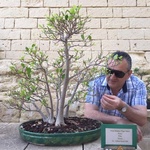
cosmos- Member
 Re: Casuarina Equisetifolia (Cemara Udang or Mu Ma Huang)
Re: Casuarina Equisetifolia (Cemara Udang or Mu Ma Huang)

Above is an example of how to create nebari on casuarina. Casuarina issue multiple adventitious roots from the trunk and branches, if the proper humidity is administered. I have noticed that during the rainy season and because of the increase in humidity levels, field specimens and those in the wild develop hundreds of reddish roots.
taking advantage of this, one can create similar conditions by increasing the surface humudity of the basal area of the trees to promote the development of root tissue. Once these havfe emerged, they are encouraged to grow further and are directed towards tubes that grow into the ground by PVC half pipes. The tubes are filled with soil and once the roots hit the ground, they fatten up.
This technique works quite well. The only drawback i consider is that the radial root structure is TOO perfect, thus resulting in an unatural look. In my opinion, roping some of the roots and further promotion of fibrous rootage from certain vantage points will create a more stable and appealing root structure.
I hope this short essay answers some of your questions.
Kind regards,
Jose Luis
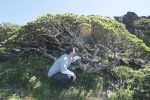
jrodriguez- Member
 Creating a great nebari on Casuarina
Creating a great nebari on Casuarina
Waw indeed,
The pictures are really great. I agree with you that a TOO perfect nebari would look most unatural. The only thing I cannot understand is what happens when the roots fatten up and they need to be cut back into the pot. I can only presume that surely they need to be cut back, repot the tree so that the end cuts of the roots could be burried and hope that these ends of the roots also grow finer roots. Or do the fattened roots as they were growing and getting fat, send finer roots from their underside into the potting mixture?
Thanks again for your help. YOU KEPT YOUR WORD.
Cosmos
The pictures are really great. I agree with you that a TOO perfect nebari would look most unatural. The only thing I cannot understand is what happens when the roots fatten up and they need to be cut back into the pot. I can only presume that surely they need to be cut back, repot the tree so that the end cuts of the roots could be burried and hope that these ends of the roots also grow finer roots. Or do the fattened roots as they were growing and getting fat, send finer roots from their underside into the potting mixture?
Thanks again for your help. YOU KEPT YOUR WORD.
Cosmos

cosmos- Member
 Casuarina equisetifolia
Casuarina equisetifolia
Hi Jose Luis,
Thanks again for the pictures you shared with us. I see that there are many more casuarinas in training in the foreground. Have they all been grown from seed or air-layers?
Regards
Cosmos
Thanks again for the pictures you shared with us. I see that there are many more casuarinas in training in the foreground. Have they all been grown from seed or air-layers?
Regards
Cosmos

cosmos- Member
 casuarina
casuarina
in the Philippines the local name of casuarina is agoho its one of my favorites. I have a few in my garden I will try to post it soon

Ka Pabling- Member
 Re: Casuarina Equisetifolia (Cemara Udang or Mu Ma Huang)
Re: Casuarina Equisetifolia (Cemara Udang or Mu Ma Huang)
Pady,
Indeed, agoho is the name in the Phillippines for casuarina.
Please post some pics and include some Balete, bantigue and lemoncito.
Kind regards,
jose luis
Indeed, agoho is the name in the Phillippines for casuarina.
Please post some pics and include some Balete, bantigue and lemoncito.
Kind regards,
jose luis

jrodriguez- Member
 Re: Casuarina Equisetifolia (Cemara Udang or Mu Ma Huang)
Re: Casuarina Equisetifolia (Cemara Udang or Mu Ma Huang)
Here are some pictures of Casuarina Equisetifolia (Agoho or cemara udang or mu ma huang) Pemphis acidula (bantigue ) various species of balete mostly red balete, Murraya paniculata(jasmin, kamuning) and Tamarindus SP (Sampaloc). I dont have a lemoncito right now I am not so keen to it. I will try to post other tropical species next time. I don't know if I uploaded these pictures correctly, but it's probably in my gallery. Anyone who can give me tutorial will be highly appreciated. 

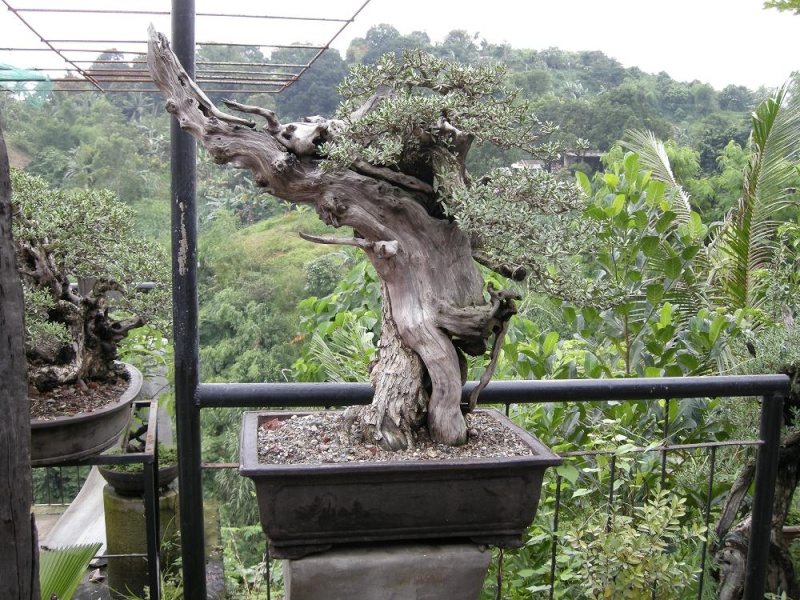

 [code]
[code]



 [code]
[code]Last edited by padychitan on Tue Aug 04, 2009 11:32 am; edited 2 times in total (Reason for editing : add pictures)

Ka Pabling- Member
 Re: Casuarina Equisetifolia (Cemara Udang or Mu Ma Huang)
Re: Casuarina Equisetifolia (Cemara Udang or Mu Ma Huang)
Pady,
Lemoncito (Triphasia Trifolia) is a good species for bonsai. Unfortunately, getting on with a thick trunk is very hard. I have one with a very beautiful trunk. I will try to post it later in a different thread. By the way, you bantigue is beautiful. When they develop more they will be very stunning.
Thanks for posting the trees. Are you from Pangasinan?
Kind regards,
Jose Luis
Lemoncito (Triphasia Trifolia) is a good species for bonsai. Unfortunately, getting on with a thick trunk is very hard. I have one with a very beautiful trunk. I will try to post it later in a different thread. By the way, you bantigue is beautiful. When they develop more they will be very stunning.
Thanks for posting the trees. Are you from Pangasinan?
Kind regards,
Jose Luis

jrodriguez- Member
 Casuarina Equisetifolia (Cemara Udang or Mu Ma Huang)
Casuarina Equisetifolia (Cemara Udang or Mu Ma Huang)
I used to have some lemonsitos but the trunks are not so impresive so I got rid of them.Yes lemonsitos are good for bonsai they look great specially when they are in bloom.
I am from Antipolo City, have you ever been to Pangasinan?, or you know somebody from there.
I am from Antipolo City, have you ever been to Pangasinan?, or you know somebody from there.

Ka Pabling- Member
 Re: Casuarina Equisetifolia (Cemara Udang or Mu Ma Huang)
Re: Casuarina Equisetifolia (Cemara Udang or Mu Ma Huang)
Pady,
I know a lot of people from Phllippines. Mr. Bobby Gopiao, Mr. Yumie Gupit, Mr. Fely Gupit and many others. Also, MR. Ogi Uyehara is my friend.
Kind regards,
Jose Luis
I know a lot of people from Phllippines. Mr. Bobby Gopiao, Mr. Yumie Gupit, Mr. Fely Gupit and many others. Also, MR. Ogi Uyehara is my friend.
Kind regards,
Jose Luis

jrodriguez- Member
 Re: Casuarina Equisetifolia (Cemara Udang or Mu Ma Huang)
Re: Casuarina Equisetifolia (Cemara Udang or Mu Ma Huang)
[quote="padychitan"]Here are some pictures of Casuarina Equisetifolia (Agoho or cemara udang or mu ma huang) Pemphis acidula (bantigue ) various species of balete mostly red balete, Murraya paniculata(jasmin, kamuning) and Tamarindus SP (Sampaloc). I dont have a lemoncito right now I am not so keen to it. I will try to post other tropical species next time. I don't know if I uploaded these pictures correctly, but it's probably in my gallery. Anyone who can give me tutorial will be highly appreciated. 
_______________________________
I would like to see the orange jasmine, Murraya p if you get a chance.
ciao.....Leonardo
_______________________________
I would like to see the orange jasmine, Murraya p if you get a chance.
ciao.....Leonardo
leonardo- Member
 Re: Casuarina Equisetifolia (Cemara Udang or Mu Ma Huang)
Re: Casuarina Equisetifolia (Cemara Udang or Mu Ma Huang)
jrodriguez wrote:Pady,
I know a lot of people from Phllippines. Mr. Bobby Gopiao, Mr. Yumie Gupit, Mr. Fely Gupit and many others. Also, MR. Ogi Uyehara is my friend.
Kind regards,
Jose Luis
All from PBSI, they are my good friends too. I suppose you have visited the Phil, already?
Is there a way you can post the other winners of WBFF photo contest?
Best regards
Pabling

Ka Pabling- Member
 Agoho
Agoho
Hi Pady,
Is that last Agoho a yamadori? What mix do you use to grow your Agoho?
Thanks for sharing.
Cosmos
Is that last Agoho a yamadori? What mix do you use to grow your Agoho?
Thanks for sharing.
Cosmos

cosmos- Member
 Agoho (casuarina equisetifolia}
Agoho (casuarina equisetifolia}
Hi Cosmos
Yes it is yamadori, I think more than 95% of our trees here are yamadori. I use river sand for all species that are collected from the coast like bantigue, agoho, bantulinao etc., growing in rocks and sand is their natural habitat.
You can only get trees with this kind of trunks if they are collected fron the coast.
Yes it is yamadori, I think more than 95% of our trees here are yamadori. I use river sand for all species that are collected from the coast like bantigue, agoho, bantulinao etc., growing in rocks and sand is their natural habitat.
You can only get trees with this kind of trunks if they are collected fron the coast.

Ka Pabling- Member
 Re: Casuarina Equisetifolia (Cemara Udang or Mu Ma Huang)
Re: Casuarina Equisetifolia (Cemara Udang or Mu Ma Huang)
Hi padychitan
Thanks for your reply. I tried to collect two yamadori but failed. I left the soil from the site I picked up the tree since I have read on Bonsai Focus and other books, that the roots of casuarina has a symbiotic relationship with a fungus and also have minute root nodules with bacteria that change atmospheric nitrogen into usuable nitrates. I thought that making a new mix for the yamadori would upset such associations and what you are telling me i.e. using river sand alone, would not be conducive to craeting such mutalisms. Can you pl elaborate on how you carry out your yamadori on such trees.
Thanks
Cosmos
Thanks for your reply. I tried to collect two yamadori but failed. I left the soil from the site I picked up the tree since I have read on Bonsai Focus and other books, that the roots of casuarina has a symbiotic relationship with a fungus and also have minute root nodules with bacteria that change atmospheric nitrogen into usuable nitrates. I thought that making a new mix for the yamadori would upset such associations and what you are telling me i.e. using river sand alone, would not be conducive to craeting such mutalisms. Can you pl elaborate on how you carry out your yamadori on such trees.
Thanks
Cosmos

cosmos- Member
 Re: Casuarina Equisetifolia (Cemara Udang or Mu Ma Huang)
Re: Casuarina Equisetifolia (Cemara Udang or Mu Ma Huang)
Hi Cosmos
I think that what you are telling about a "symbiotic relationship with a fungus and minute root nodules with bacteria etc." does not only apply to casuarinas but to all yamadori. It is a good practice to bring a portion of the soil where you dig the yamadori and mix it to your potting medium so the useful bacteria present in that soil could multiply in the new medium.The use of humic acid can help this usefull bacteria multiply.
I use volcanic cynder and course river sand as medium for my casuarinas for good draining. Casuarinas hate to be waterlogged.It has been our experience to leave some branchlets of collected casuarinas for better survival. Those that are totaly defoliated usualy dont suirvive.
Pabling
I think that what you are telling about a "symbiotic relationship with a fungus and minute root nodules with bacteria etc." does not only apply to casuarinas but to all yamadori. It is a good practice to bring a portion of the soil where you dig the yamadori and mix it to your potting medium so the useful bacteria present in that soil could multiply in the new medium.The use of humic acid can help this usefull bacteria multiply.
I use volcanic cynder and course river sand as medium for my casuarinas for good draining. Casuarinas hate to be waterlogged.It has been our experience to leave some branchlets of collected casuarinas for better survival. Those that are totaly defoliated usualy dont suirvive.
Pabling

Ka Pabling- Member
 Re: Casuarina Equisetifolia (Cemara Udang or Mu Ma Huang)
Re: Casuarina Equisetifolia (Cemara Udang or Mu Ma Huang)
Hi padychitan
Thanks for the information you shared. Indeed, it will become very useful when I attempt another yamadori. All my yamadori had no branches and perhaps also the mix I used was not that optimal.
While googling around on casuarinas I found a photo (that I am trying to change into a type that can be posted; but dont know how as yet) of a casuarina tree to which some casuarina saplings have been 'welded'. It appears that the technique is similar to that used to fatten ficus, whereby several ficus saplings are nailed and wrapped around a more mature ficus until these saplings fuse and weld wth the mother plant. Do you have any experience with such a technique on casuarinas?
Thanks again.
Cosmos
Thanks for the information you shared. Indeed, it will become very useful when I attempt another yamadori. All my yamadori had no branches and perhaps also the mix I used was not that optimal.
While googling around on casuarinas I found a photo (that I am trying to change into a type that can be posted; but dont know how as yet) of a casuarina tree to which some casuarina saplings have been 'welded'. It appears that the technique is similar to that used to fatten ficus, whereby several ficus saplings are nailed and wrapped around a more mature ficus until these saplings fuse and weld wth the mother plant. Do you have any experience with such a technique on casuarinas?
Thanks again.
Cosmos

cosmos- Member
 agoho
agoho
This technique of fusing is a very comon to ficus, I often do this to microcarpa, in just one year it will fuse perfectly well but I have not tried it with casuarina. In the pic you posted It seems it works well! Its easier to get casuarina saplings from nurseries.
What I do with microcarpa is to bind together about four sa[lings, one each for the first branch back branch second branch and for the crown then program it this early, in one year I will have a semi finished bonsai. I will try this with casuarina. Thanks for the tip.
Regards
Pabling
What I do with microcarpa is to bind together about four sa[lings, one each for the first branch back branch second branch and for the crown then program it this early, in one year I will have a semi finished bonsai. I will try this with casuarina. Thanks for the tip.
Regards
Pabling

Ka Pabling- Member
 Re: Casuarina Equisetifolia (Cemara Udang or Mu Ma Huang)
Re: Casuarina Equisetifolia (Cemara Udang or Mu Ma Huang)
hi Mang Pabling ! i saw ur bonsai in this forum and they all great, is been quit a while since our group see each other( KPBSI) ,i hope one of dis day BOY and I will visit ur place .i also had new yamadori casuarina ,one of dis ill post d pictures.
regards
Allan ,(secrataryPBSI)
regards
Allan ,(secrataryPBSI)
allan- Member
 Re: Casuarina Equisetifolia (Cemara Udang or Mu Ma Huang)
Re: Casuarina Equisetifolia (Cemara Udang or Mu Ma Huang)
my yamadori casuarina semi cascade

allan- Member
Page 2 of 5 •  1, 2, 3, 4, 5
1, 2, 3, 4, 5 
 Similar topics
Similar topics» Casuarina equisetifolia
» Casuarina equisetifolia
» Casuarina equisetifolia
» Casuarina equisetifolia Development
» Large Casuarina equisetifolia
» Casuarina equisetifolia
» Casuarina equisetifolia
» Casuarina equisetifolia Development
» Large Casuarina equisetifolia
Page 2 of 5
Permissions in this forum:
You cannot reply to topics in this forum







